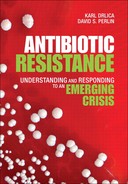Preface
Recent human activities have profoundly influenced our global environment, often in ways we did not anticipate. An example is our use of antibiotics. Initially hailed as “magic bullets,” these chemical agents are now used so often that success threatens their long-term utility. Unfortunately, the natural mutability of microbes enables pathogens to develop bullet-proof shields that make antibiotic treatments increasingly ineffective. Our failure to adequately address resistance problems may ultimately push the control of infectious disease back to the pre-penicillin era. Indeed, it is now impractical to simply invent additional antibiotics to replace those lost to resistance. However, ideas have emerged for slowing the development of antibiotic resistance in individual patients and in the human population as a whole. Antibiotic Resistance introduces these ideas.
Antibiotic Resistance was initially drafted to supplement studies of infectious disease. The problem of resistance tends to be neglected, which puts the well-being of our society at increasing peril. In the course of completing this book, we realized that everyone makes decisions about antibiotic use; therefore, everyone needs to understand how human activities contribute to resistance. Individual patients, medical providers, and agricultural specialists all have a role to play in providing a safer environment. We now aim to make the principles of antibiotic use and effectiveness available to a large audience: farmers, hospital administrators, government regulators, health department personnel, pharmaceutical executives, and especially individual users. (Individual patients pressure their doctors for treatments, and in most cases, patients decide whether to take medicines as prescribed; in countries where prescriptions are not required to purchase antibiotics, patients are major decision makers.) Such diversity in readership poses a challenge.
Fortunately, detailed descriptions of chemical structures, molecular mechanisms, and epidemiological modeling are not required to understand the principles of resistance. We focus on broad concepts supported by examples and descriptions of key experiments. We expect that Antibiotic Resistance will be a quick read for persons with knowledge of biology. Those readers can then build on the principles with follow-up reading. Lay readers may find that some terms need to be defined. For them, we have provided a glossary and appendixes covering background concepts.
Our goal with Antibiotic Resistance is to point out how human activities contribute to the problem of resistance. Our hope is that an understanding of the complex factors involved in resistance will lead to changes that lengthen antibiotic life spans. An example of the complexity is seen in the traditional practice of setting antibiotic doses only high enough to cure disease. We argue that this practice encourages the emergence of resistance, that more stringent antibiotic regimens are needed to preempt the emergence of resistance. But from an individual patient perspective, using higher doses seems excessive when milder treatment usually cures disease. Why should the individual patient risk toxic side effects to preserve antibiotics for the general population?
Antibiotic waste disposal problems are also complex. In principle, environmental contamination with antibiotics exerts selective pressure on microbes. That pressure can lead to the evolution of resistance genes that then spread from one organism to another and eventually reach human pathogens. We do not know how often this scenario occurs, whether it is reversible, or how much we need to improve agricultural and hospital disposal programs to stop the process.
Fortunately, many resistance issues are not complex. For example, wearing contaminated gloves can spread drug-resistant disease in hospitals: More attention to hand hygiene is required. We are confident that an improved understanding of antibiotic resistance can help preserve these valuable agents.
Each year, thousands of scientific papers are published on antibiotic resistance, making it difficult for even a pair of authors to get everything right. To improve accuracy, we obtained help from David Alland, Vivian Bellofatto, Arnold Bendich, Purnima Bhanot, John Bradley, Dorothy Fallows, Alexander Firsov, Patrick Fitzgerald, Marila Gennaro, Tao Hong, Dairmaid Hughes, Robert Kerns, Barry Kreiswirth, Shajo Kunnath, David Lukac, Simon Lynch, Muhammad Malik, Barun Mathema, Ellen Murphy, Christina Ohnsman, Richard Pine, Lynn Ripley, Snezna Rogelj, Bo Shopsin, llene Wagner, Heinz-Georg Wetstein, Xilin Zhao, and Stephen Zinner. We sincerely thank them for their time and for sharing their knowledge.
